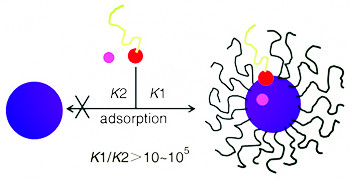• 综述与评论 •
陈峰, 万德成. 超分子化学中的多点统计作用:设计与应用[J]. 化学进展, 2015, 27(7): 841-847.
Chen Feng, Wan Decheng. Multisite Statistical Interactions in Supramolecular Chemistry: Design and Application[J]. Progress in Chemistry, 2015, 27(7): 841-847.

中图分类号:
分享此文:
| [1] Mammen M, Choi S K, Whitesides G M. Angew. Chem. Int. Ed., 1998, 37: 2754. [2] James T D, Sandanayake K R A S, Shinkai S. Angew. Chem., Int. Ed., 1996, 35: 1910. [3] van Velzen E U T, Engbersen J F J, Reinhoudt D N. J. Am. Chem. Soc., 1994, 116: 3597. [4] Huisman B H, Rudkevich D M, van Veggel F C J M, Reinhoudt D N. J. Am. Chem. Soc., 1996, 118: 3523. [5] Angelova P, Solel E, Parvari G, Turchanin A, Botoshansky M, Golzhauser A, Keinan E. Langmuir, 2013, 29: 2217. [6] Kelly B C, Ikonomou M G, Blair J D, Morin A E, Gobas F A P C. Science, 2007, 317, 236. [7] Fisk A T, Norstrom R J, Cymbalisty C D, Muir D. C G. Environ. Toxicol. Chem., 1998, 17: 951. [8] Connolly J P, Pedersen C J. Environ. Sci. Technol., 1988, 22: 99. [9] Beyer J, Jonsson G, Porte C, Krahn M M, Ariese F. Environ. Toxicol. Phar., 2010, 30: 224. [10] Wan D C, Chen F, Geng Q R, Lu H, Willcock H, Liu Q M, Wang F Y K, Zou K D, Jin M, Pu H T, Du J Z. Sci. Rep., 2014, 4: 7296. [11] Feng X, Fryxell G E, Wang L Q, Kim A Y, Liu J, Kemner K M. Science, 1997, 276: 923. [12] Mercier L,Pinnavaia T J. Adv. Mater., 1997, 9: 500. [13] Walcarius A, Mercier L. J. Mater. Chem., 2010, 20: 4478. [14] Chen F, Wan D C, Jin M, Pu H T. submitted. [15] Wang Y L, Liu M B, Xie L Q, Fang C Y, Xiong H M, Lu H J. Anal. Chem., 2014, 86: 2057. [16] Chen F, Wan D C, Chang Z H, Pu H T, Jin M. Langmuir, 2014, 30: 12250. [17] Balzani V, Ceroni P, Gestermann S, Gorka M, Kauffmann C, Vogtle F. Tetrahedron, 2002, 58: 629. [18] 万德成 (Wan D C), 金明 (Jin M), 浦鸿汀 (Pu H T). 化学进展 (Progress in Chemistry), 2011, 23: 2095. [19] Wan D C, Jin M, Pu H T, Pan H Y, Chang Z H. React. Funct. Polym., 2010, 70: 916. [20] Tian W, Lv A L, Xie Y C, Wei X Y, Liu B W, Lv X Y. RSC Adv., 2012, 2: 11976. [21] Tian W, Fan X D, Kong J, Liu Y Y, Liu T, Huang Y. Polymer, 2010, 51: 2556. [22] Zhou Y M, Tian W, Yang G, Fan X D. Beilstein J. Org. Chem. 2014, 10: 2696. [23] Tian W, Wei X Y, Liu Y Y, Fan X D. Poly. Chem., 2013, 4: 2850. [24] Wan D C, Pu H T, Jin M, Wang G W, Huang J L. J. Polym. Sci., Part A: Polym. Chem., 2011, 49: 2373. [25] Zhang P, Yin J, Jiang X S. Langmuir, 2014, 30: 14597. [26] Deng S J, Xu H J, Jiang X S, Yin J. Macromolecules, 2013, 46: 2399. [27] Wang R, Yu B, Jiang X S, Yin J. Adv. Funct. Mater. 2012, 12: 2606. [28] Li B, Jiang X S, Yin J. J. Mater. Chem., 2012, 22: 17976. [29] Wan D C, Liu H H, Jin M, Pu H T. Eur. Polym. J., 2014, 55: 9. [30] Newkome G R, Moorefield C N, Baker G R, Johnson A L, Behera R K. Angew. Chem. Int. Ed., 1991, 30: 1176. [31] Tomalia D A, Naylor A, Goddard W A. Angew. Chem. Int. Ed., 1990, 29: 138. [32] Jansen J F G A, de Brabander-van den Berg E M M, Meijer E W. Science, 1994, 266: 1226. [33] Sunder A, Kramer M, Hanselmann R, Mulhaupt, Frey H. Angew. Chem. Int. Ed., 1999, 38: 3552. [34] Stiriba S E, Kautz H, Frey H. J. Am. Chem. Soc., 2002, 124: 9698. [35] Chen Y, Shen Z, Pastor-Perez L, Frey H, Stiriba S E. Macromolecules, 2005, 38: 227. [36] Wan D C, Pu H T, Cai X Y. Macromolecules, 2008, 41: 7787. [37] Liu H J, Chen Y, Zhu D D, Shen Z, Stiriba S E. React. Funct. Poly., 2007, 67: 383. [38] Liu H H, Yang P F, Wan D C. J. Polym. Sci., Part B: Polym. Phys., 2015, 53: 566. |
| [1] | 王芷铉, 郑少奎. 选择性离子吸附原理与材料制备[J]. 化学进展, 2023, 35(5): 780-793. |
| [2] | 兰明岩, 张秀武, 楚弘宇, 王崇臣. MIL-101(Fe)及其复合物催化去除污染物:合成、性能及机理[J]. 化学进展, 2023, 35(3): 458-474. |
| [3] | 杨世迎, 李乾凤, 吴随, 张维银. 铁基材料改性零价铝的作用机制及应用[J]. 化学进展, 2022, 34(9): 2081-2093. |
| [4] | 张沐雅, 刘嘉琪, 陈旺, 王利强, 陈杰, 梁毅. 蛋白质凝聚作用在神经退行性疾病中的作用机制研究[J]. 化学进展, 2022, 34(7): 1619-1625. |
| [5] | 韩冬雪, 金雪, 苗碗根, 焦体峰, 段鹏飞. 超分子组装体激发态手性的响应性[J]. 化学进展, 2022, 34(6): 1252-1262. |
| [6] | 李诗宇, 阴永光, 史建波, 江桂斌. 共价有机框架在水中二价汞吸附去除中的应用[J]. 化学进展, 2022, 34(5): 1017-1025. |
| [7] | 尹晓庆, 陈玮豪, 邓博苑, 张佳路, 刘婉琪, 彭开铭. 超润湿膜在乳化液破乳中的应用及作用机制[J]. 化学进展, 2022, 34(3): 580-592. |
| [8] | 徐妍, 苑春刚. 纳米零价铁复合材料制备、稳定方法及其水处理应用[J]. 化学进展, 2022, 34(3): 717-742. |
| [9] | 闫保有, 李旭飞, 黄维秋, 王鑫雅, 张镇, 朱兵. 氨/醛基金属有机骨架材料合成及其在吸附分离中的应用[J]. 化学进展, 2022, 34(11): 2417-2431. |
| [10] | 占兴, 熊巍, 梁国熙. 从废水到新能源:光催化燃料电池的优化与应用[J]. 化学进展, 2022, 34(11): 2503-2516. |
| [11] | 吴明明, 林凯歌, 阿依登古丽·木合亚提, 陈诚. 超浸润光热材料的构筑及其多功能应用研究[J]. 化学进展, 2022, 34(10): 2302-2315. |
| [12] | 曹新华, 韩晴晴, 高爱萍, 王桂霞. 气态酸和有机胺响应的超分子凝胶[J]. 化学进展, 2021, 33(9): 1538-1549. |
| [13] | 张静, 王定祥, 张宏龙. 高价锰、铁去除水中新兴有机污染物[J]. 化学进展, 2021, 33(7): 1201-1211. |
| [14] | 胡豪, 何云鹏, 杨水金. 多酸@金属-有机骨架材料的制备及其在废水处理中的应用[J]. 化学进展, 2021, 33(6): 1026-1034. |
| [15] | 李立清, 吴盼旺, 马杰. 双网络凝胶吸附剂的构建及其去除水中污染物的应用[J]. 化学进展, 2021, 33(6): 1010-1025. |
| 阅读次数 | ||||||
|
全文 |
|
|||||
|
摘要 |
|
|||||